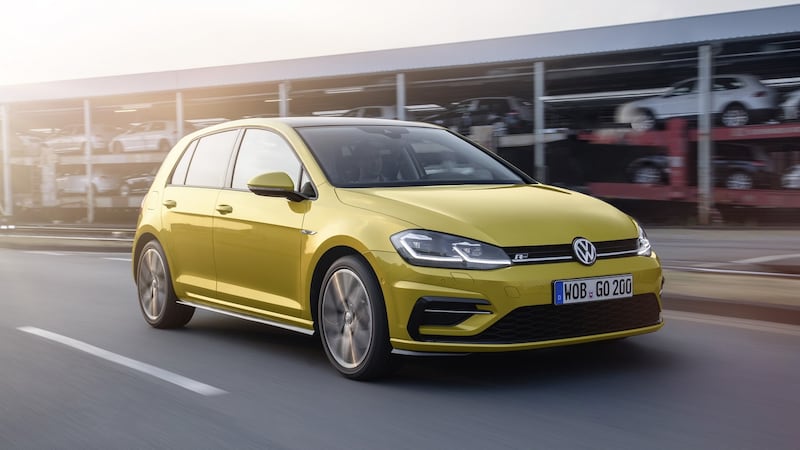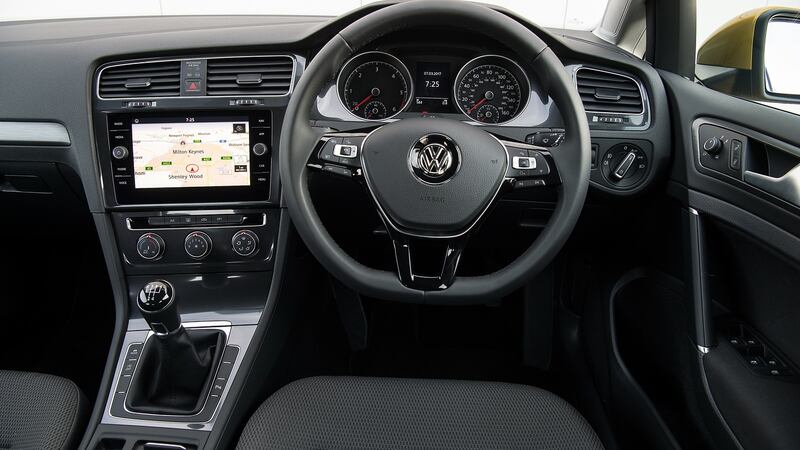In the midst of the convoy of crossover SUVs crowding our streets, the arrival of a new hatchback garners little fanfare. All eyes and desires are fixed on mock off-roaders these days.
Engineers and more eagle-eyed readers may explain that these new star cars are little more than the same family hatchbacks hoisted an extra few feet into the air. They might as well be trying to teach evolution to religious fundamentalists; the majority of new-car buyers have been carried away by crossover-mania.
So it’s time to return to some motoring fundamentals, and where better than in the latest iteration of that motoring equivalent of the comfortable couch, the Volkswagen Golf. Seven generations in and the car may have grown significantly, it may have adopted sleeker lines and snazzy tech gadgetry, but even the most myopic among us can recognise the Golf’s silhouette.
There is a case for mixing it up in design terms every so often, but you only have to consider the state of the Honda Civic to think twice. It’s a motoring Chameleon, to the extent it has little or no identity.
The Golf’s latest iteration comes as the brand tries to shake off its starring role in a push against diesel, due in part to the VW emissions scandal. Suddenly Europe has woken up to the harmful health affect of nitrogen oxides (NOx) in the air.
Petrol is regaining popularity. Sure, it might melt a few more ice caps, but it won’t choke the children. And it always made more sense for low mileage motorists.
So petrol is back in fashion and small petrol engines have been the star act for the past two years. Long-term Golfers will struggle with the idea of buying a 1-litre petrol-powered version, particularly if they’ve spent several years burning diesel to get around. Yet they need to set aside any prejudices – and words of wisdom from the “diesel’s your only man” sales staff – for engine technology has gone back for the future.
Remember back in 2009 when the sales guy – invariably a guy – grimaced at the petrol car you were trading in and warned that petrol had had its day. You bit the bullet and took a €3,000 hit on the trade-in on the promise that you were now future-proofing your motoring investment by opting for the “cleaner” diesel. Fast forward to Spring 2017. You’ve made it through the recession with at least a shirt on your back and the same car on the driveway. Time to change. Same sales guy, same grimace. “Petrol’s your only man” but you can now future-proof your motoring future. You’re going to take a hit, however, of about €3,000 on the diesel trade-in. You’re left wondering if your experience is a worthy defence for justifiable homicide.

In general diesel variants have always cost more than their petrol equivalents and even with the lower annual motor tax and the few cents you save on every litre of fuel, you need to clock up a lot of mileage to make up the difference. Then there are the extra servicing costs, particularly if you don’t do enough higher speed driving to clear out the diesel particulate filter.
So if you do bite the bullet and opt for the small petrol what do you get? Well, on the technical front you get a very smart Golf that’s faster off the blocks than the 1.6-litre diesel that has been the standard bearer for this model to date. The 1-litre petrol delivers 110bhp and a 0-100km/h time of 9.6 seconds, compared to the diesel’s 115bhp and 10.2 seconds. The diesel obviously packs a stronger punch in terms of torque – 250Nm compared to 200Nm of the petrol. However, this 1-litre does weigh in at 90kg less than the diesel, which goes some way to balancing the difference.
Turning to the all-important financials, the petrol delivers an official figure of 4.8 l/100km against the diesel’s 4.1 l/100km. A few seconds on the back of an envelope based on prices of 137 cent a litre for petrol and 126 cent for diesel throws up some useful costs. If you are a suburban commuter doing 12,000km a year that means an annual fuel bill of €576 for the petrol against €492 for the diesel. The diesel is also €10 a year cheaper on motor tax. So a grand annual savings of €94. At those admittedly crude calculations it would take you 22 years to recoup the €2,100 price difference between an equivalent new 1-litre petrol and 1.6-litre Golf.
It’s true that the diesel’s low-rev punch is more impressive but the expected whine from the small petrol engine never materialises. It’s a nippy, smooth performer and cruises well at motorway speeds, though you are best opting for the six-speed 110bhp rather than the entry level 85bhp five-speed.
It’s comfortable too, and even though it gets a more standard rear suspension instead of the more sophisticated multi-link arrangement in the higher powered Golfs, it’s still one of the most refined family hatchbacks on the market. And that goes for the interior as well.
I dislike VW’s move to abandon all buttons and knobs in favour for a touchscreen system that lacks any tactile element so you never know if you’ve pressed the button or not, but it’s got a definite premium air about the cabin, particularly at mid-level Comfortline or Highline grade.
One good litmus test for a car is the sense you get in the wee small hours of a wet Wednesday morning. As the rain splatters against the glass on the porch door and you prepare to make a dash for the car, the Golf offers a welcoming shelter. I’ve had much faster and stylish cars on the driveway that offer multiples of fun over this little Golf, but the VW gives a sense of reassurance the others don’t on such mornings. You know what you’re getting and you know it’s going to be nice.
In terms of rivals, the Ford Focus 1-litre petrol version is another cracking good car and the ST Line version with 125bhp is priced at €24,875. It’s as sharp to drive as well.
Yet the Golf retains that quasi-premium aura its rivals can’t match. It’s as well suited to the drive of a 50-acre Edwardian pile in Co Kildare as it is to a cramped housing estate.

So as we await the onset of affordable electric cars with decent ranges between charges, the story is one of petrol good and diesel dirty. And even the bean counters can make a viable case for most of us to make the move, particularly when car firms are coming up with such impressive little petrol engines.
Lowdown: VW Golf 1-litre 110bhp 6-speed 5-door Highline
Engine: 999cc 110bhp @ 4,600rpm and 200Nm of torque from 1,400rpm
0-100km/h (max speed): 9.9 seconds (196km/h)
L/100km (mpg): 4.8 (58.8)
Emissions (motor tax): 109 g/km (€200)
Price: €27,295 (€30,211 as tested)
Our verdict: For most buyers this is the engine to opt for and the Golf remains the icon of family hatchbacks
Our rating: 4/5












